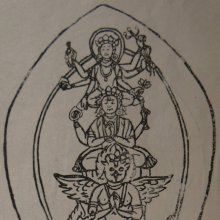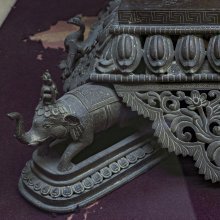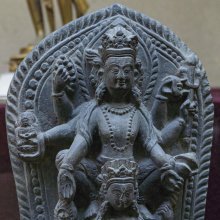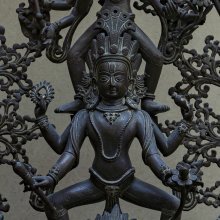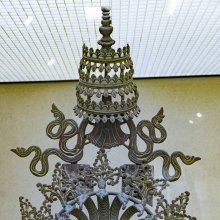Harihariharivahanalokeshvara, Harihariharivāhanalokeśvara, Harihariharivahana-lokeshvara: 1 definition
Introduction:
Harihariharivahanalokeshvara means something in Buddhism, Pali. If you want to know the exact meaning, history, etymology or English translation of this term then check out the descriptions on this page. Add your comment or reference to a book if you want to contribute to this summary article.
The Sanskrit term Harihariharivāhanalokeśvara can be transliterated into English as Harihariharivahanalokesvara or Harihariharivahanalokeshvara, using the IAST transliteration scheme (?).
Images (photo gallery)
(+3 more images available)
In Buddhism
Tibetan Buddhism (Vajrayana or tantric Buddhism)
Source: archive.org: The Indian Buddhist Iconography1) Harihariharivāhanalokeśvara (हरिहरिहरिवाहनलोकेश्वर) or simply Harihariharivāhana refers to one of the various forms of Avalokiteśvara having their Sādhana described in the 5th-century Sādhanamālā (a collection of sādhana texts that contain detailed instructions for rituals).—His Colour is white; his Vāhana is Siṃha, Garuḍa and Viṣṇu; He has six arms.—The composition of the deity is so queer that great difficulty is experienced in recognizing the images of this form of Avalokiteśvara, called by the peculiar name of Harihariharivāhana. The Sādhana gives a description of the god, but is practically silent as to why such a special name is given to this particular variety of Lokeśvara.
2) Harihariharivāhanalokeśvara (हरिहरिहरिवाहनलोकेश्वर) or simply Harihariharivāhana refers to number 4 of the 108 forms of Avalokiteśvara found in the Machhandar Vahal (Kathmanu, Nepal). [Machhandar or Machandar is another name for for Matsyendra.]. [...]The names of the 108 deities [viz., Harihariharivāhanalokeśvara] possbily originate from a Tantra included in the Kagyur which is named “the 108 names of Avalokiteshvara”, however it is not yet certain that this is the source for the Nepali descriptions. Tibetan Buddhism includes schools such as Nyingma, Kadampa, Kagyu and Gelug. Their primary canon of literature is divided in two broad categories: The Kangyur, which consists of Buddha’s words, and the Tengyur, which includes commentaries from various sources. Esotericism and tantra techniques (vajrayāna) are collected indepently.
See also (Relevant definitions)
Partial matches: Lokeshvara, Harihariharivahana.
Full-text: Harihariharivahana.
Relevant text
Search found 1 books and stories containing Harihariharivahanalokeshvara, Harihariharivāhanalokeśvara, Harihariharivahana-lokeshvara, Harihariharivāhana-lokeśvara, Harihariharivahanalokesvara, Harihariharivahana-lokesvara; (plurals include: Harihariharivahanalokeshvaras, Harihariharivāhanalokeśvaras, lokeshvaras, lokeśvaras, Harihariharivahanalokesvaras, lokesvaras). You can also click to the full overview containing English textual excerpts. Below are direct links for the most relevant articles:
The Indian Buddhist Iconography (by Benoytosh Bhattachacharyya)
